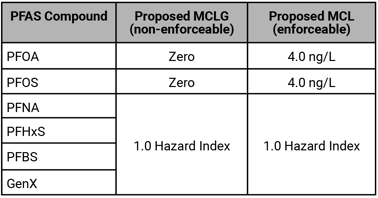In 2018, New Jersey became the first state to establish a maximum contaminant level (MCL)1 for per- and polyfluorinated alkyl substances (PFAS).2 Now, nearly five years later, the U.S. Environmental Protection Agency (USEPA or the Agency) is taking the same action. On March 14, pursuant to its authority under the Safe Drinking Water Act, the USEPA proposed strict MCLs for the following PFAS compounds: (1) perfluorooctanoic acid (PFOA); (2) perfluorooctanesulfonic acid (PFOS); (3) perfluorononanoic acid (PFNA); (4) hexafluoropropylene oxide dimer acid, commonly referred to as GenX; (5) perfluorohexane sulfonic acid (PFHxS); and (6) perfluorobutane sulfonic acid (PFBS). According to the proposal, PFOA and PFOS will be regulated as individual contaminants, and PFHxS, PFNA, PFBS, and GenX will be regulated as a PFAS mixture. In addition to MCLs, USEPA is proposing non-enforceable maximum contaminant level goals (MCLGs)3 for the six compounds. Through this action, USEPA fulfills one of its pledges in the PFAS Strategic Roadmap.
USEPA is proposing individual MCLs for PFOA and PFOS at 4.0 nanograms per liter (ng/L) or parts per trillion and an MCLG of zero (because, according to the Agency, the two compounds represent an identified cancer risk).4 For PFHxS, GenX, PFNA, and PFBS, USEPA is proposing MCLs and MCLGs using a hazard index approach, which is a commonly used risk management approach for mixtures of chemicals that is designed to protect against all adverse effects, as opposed to a single potential effect. The following table presents the proposed PFAS MCLs and MCLGs.

USEPA expects that this proposal will be finalized by the end of 2023. Until then, no action by the regulated community is required unless an individual water purveyor operates in a state that already restricts PFAS in drinking water.5 Once the proposal is finalized, public water purveyors must (1) start monitoring for the six PFAS compounds in drinking water, (2) notify the public of the levels detected, and (3) establish treatment for the PFAS compounds if the drinking water levels exceed the established MCLs.
As reflected by the USEPA’s proposal, PFAS regulation is rapidly evolving. In New Jersey, it was recently announced that the state Assembly Environment and Solid Waste Committee will soon consider three bills relating to PFAS. The first, Bill A-4759, seeks to require New Jersey water purveyors to provide customers and local officials with notice of elevated levels of PFAS in drinking water. It would also require landlords to notify tenants of elevated PFAS in drinking water. The second, Bill A-4760, seeks to require the New Jersey Department of Environmental Protection (NJDEP) to conduct a study to assess possible regulatory outcomes for PFAS in drinking water, including the feasibility of establishing MCLs for the entire class of PFAS compounds. The third, Bill A-4761, seeks to require the NJDEP to conduct annual assessments of then-unregulated PFAS compounds for potential future regulation. It would also require the NJDEP to assess whether current and proposed MCLs for PFAS adequately protect the health of children, given that MCLs are currently established using the average adult body weight.
Nationwide, public water purveyors (and thereby their ratepayers) will be impacted once the proposed PFAS MCLs and MCLGs are finalized. To the extent they have not already done so, water purveyors should consider proactively preparing for these regulations by, among other things, sampling their water for the six PFAS compounds and evaluating potential treatment options. For any party that wishes to comment on the USEPA’s proposal, the comment period lasts for 60 days after the proposal is published in the Federal Register, which can be found at https://www.regulations.gov using Docket ID No. EPA-HQ-OW-2022-0114.
If you have any questions about PFAS, MCLs, or the USEPA’s and NJDEP’s PFAS initiatives, please contact the authors of this alert.
1 MCLs are legally enforceable regulations restricting contaminant levels in drinking water, which must be met by public water purveyors.
2 See https://www.nj.gov/dep/pfas/standards.html (setting forth New Jersey’s MCLs for PFNA (0.013 parts per billion (ppb)), PFOA (0.014 ppb), and PFOS (0.013 ppb)).
3 MCLGs represent the maximum level of a contaminant in drinking water at which there are no known or anticipated adverse effects on human health. See USEPA’s Safe Drinking Water Act webpage.
4 MCLGs are set at zero whenever there is an identified cancer risk.
5 Currently, 22 states, including New Jersey, have either proposed or adopted limits for PFAS in drinking water.









